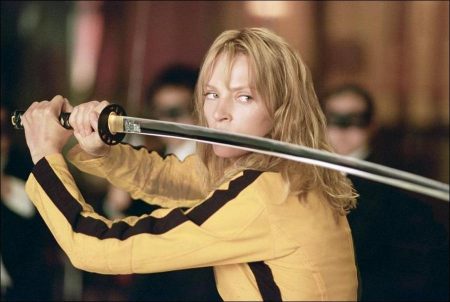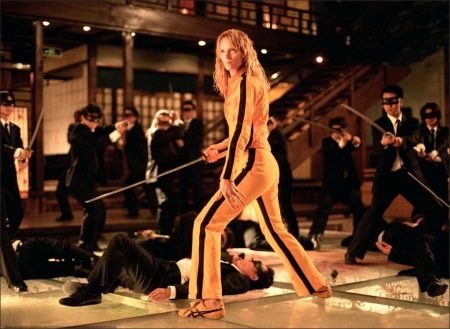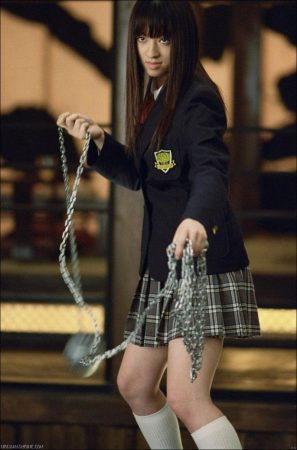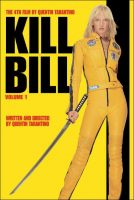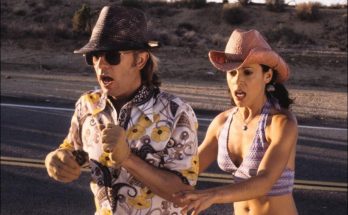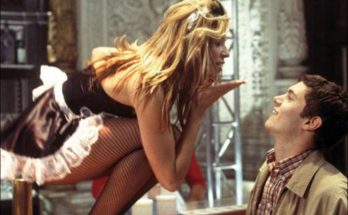Taglines: Will she kill Bill?
The fourth movie by Quentin Tarantino is an epic tale of one woman’s quest for justice presented in two installments. In Kill Bill— Vol. 1 the title character, played by David Carradine, is a mostly unseen sinister figure looming over the story who has organized an elite group called the Deadly Viper Assassination Squad (or DiVAS). All of the vipers are code-named after poisonous serpents and the deadliest of them all is Black Mamba (Uma Thurman), who is also Bill’s former lover.
Early in Vol. 1 a Texas Ranger (Michael Parks) surveys a grisly scene: an entire wedding party slaughtered during a dress rehearsal in a rural chapel. The pregnant woman in the blood-splattered wedding dress is Black Mamba, better known as The Bride.
Bill and The Vipers left The Bride for dead, but unluckily for them she was merely comatose. The Viper assassin California Mountain Snake, a.k.a. Elle Driver (Daryl Hannah), creeps into The Bride’s hospital room, disguised as a nurse and brandishing a syringe— only to be called off at the last possible moment by Bill himself.
Her first target among the wedding massacre participants is the Viper known as Cottonmouth, O-Ren Ishii (Lucy Liu). At seven O-Ren hid only inches away as her parents were killed. At age eleven she took her own bloody revenge, and has since become the first female boss-of-all-bosses of the Japanese yakuza underworld.
Kill Bill: Volume 1 (originally advertised as simply Kill Bill) is a 2003 American martial arts film written and directed by Quentin Tarantino. It stars Uma Thurman as the Bride, who swears revenge on a team of assassins (Lucy Liu, Michael Madsen, Daryl Hannah, and Vivica A. Fox) and their leader Bill (David Carradine) after they try to kill her and her unborn child. Her journey takes her to Japan, where she battles the Tokyo yakuza.
Tarantino conceived Kill Bill as an homage to “grindhouse” cinema including martial arts films, samurai cinema, blaxploitation films, and spaghetti westerns. It features an anime sequence animated by Production I.G. It is the first of two Kill Bill films made in a single production; Vol 1 was released on October 10, 2003, and the second, Kill Bill: Volume 2, was released in April 16, 2004. The films were originally set for a single release, but the film, with a runtime of over four hours, was divided in two. It became Tarantino’s highest-grossing film up to that point, earning over $180 million at the box office.
As with Tarantino’s previous films, Kill Bill features an eclectic soundtrack comprising many musical genres. On the two soundtracks, music ranges from country music to selections from the Spaghetti Western film scores of Ennio Morricone. Bernard Herrmann’s theme from the film Twisted Nerve is whistled by the menacing Elle Driver in the hospital scene. A brief, 15-second excerpt from the opening of the Ironside theme music by Quincy Jones is used as the Bride’s revenge motif, which flares up with a red-tinged flashback whenever she is in the company of her next target.
Instrumental tracks from Japanese guitarist Tomoyasu Hotei figure prominently, and after the success of Kill Bill they were frequently used in American TV commercials and at sporting events. As the Bride enters “The House of Blue Leaves”, go-go group The 5,6,7,8’s perform “I Walk Like Jayne Mansfield,” “I’m Blue (The Gong-Gong Song)” and “Woo Hoo.” The connection to Lady Snowblood is further established by the use of “The Flower of Carnage” the closing theme from that film. James Last’s “The Lonely Shepherd” by pan flute virtuoso Gheorghe Zamfir plays over the closing credits.
Kill Bill Vol. 1 (2003)
Directed by: Quentin Tarantino
Starring: Uma Thurman, Lucy Liu, Vivica A. Fox, David Carradine, Daryl Hannah, Michael Madsen, Sonny Chiba, Julie Dreyfus, Chiaki Kuriyama, Michael Parks
Screenplay by: Quentin Tarantino
Production Design by: Yohei Taneda, David Wasco
Cinematography by: Robert Richardson
Film Editing by: Sally Menke
Costume Design by: Alexander AD, Kumiko Ogawa, Catherine Marie Thomas
Set Decoration by: Yoshihito Akatsuka, Sandy Reynolds-Wasco
Music by: RZA
MPAA Rating: R for strong bloody violence, language, sexual content.
Distributed by: Miramax Films
Release Date: October 10, 2003
Visits: 126
